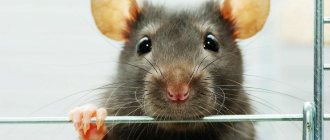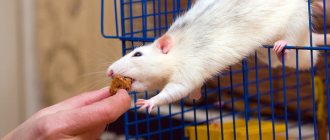What is it really like to have a pet rat? Owning a pet rat is a wonderful experience if you have the time to care for them. These rodents are especially active at night and are very social, and you should keep this in mind when deciding whether you should get a pet rat. But let's take a closer look at the pros and cons of owning a pet rat.
General characteristics of rats
Compared to men, women are more active than men, while men are more phlegmatic and somewhat lazy. But regardless of gender, rats are very affectionate and will enjoy being petted and caressed by their owners.
Read also: The meaning of the word “independence”
In addition, the following characteristics of domestic rats can be distinguished:
- purity;
- unpretentious service;
- receptive to training;
- curiosity and intelligence;
- sociability.
Keep in mind that when purchasing such an animal, each individual may have both pros and cons.
For example, a sufficiently developed intelligence can create problems: it can easily open simple locks and latches in a cage. But at the same time, the developed intelligence of the rat makes this animal unique: it recognizes its owner and can learn simple tricks.
Breeds of domestic rats
Today there are 137 species of domestic rats, as well as 570 subspecies . And each of them is interesting in its own way. The most common:
- breed of decorative rat - standard,
- tailless rats,
- rexes and double rexes,
- satin types,
- hairless,
- decorative dumbo rats,
- downy
At the same time, the color of decorative rats can be uniform, ticked (with a pattern) or combined. White domestic rats, gray domestic rats, and black decorative rats are often found. Less often - with hearts, spots and stripes.
How did domestic rats appear?
White rats first appeared in Eastern countries; in the 19th century, animals appeared in England and were used for public entertainment. Many rich people kept white rats, which were a curiosity.
Subsequently, white pets began to be used in various laboratory tests. It was at this time that special pets began to be bred, which have a large number of distinctive qualities in comparison with their gray relatives.
Why should you have a rat as a pet?
- White domestic rats are clean animals, so there is practically no dirt from the pet.
- The rodent can perform tricks while playing, so it is ideal for children.
- The animal spends most of its time in a cage, where she also sets up places for going to the toilet and a corner for eating.
- The rodent is active and, with proper training, can improve the mood of any family member; it loves to go for walks with its owners.
- If you properly care for your white pet, no difficulties will arise; the animal does not require frequent feedings or other types of additional care.
Cell selection
All a rat needs is a spacious cage with accessories, tasty nutritious food and a loving owner. A cage for a furry pet becomes a home in which it spends most of its life, so you need to pay special attention to buying a home for your little friend. A cage for a decorative rat must meet the following parameters.
Size
A tame rodent cannot be kept in a narrow, low cage; the animal needs space for the necessary movement inside the home. To keep one or two pets, it is advisable to purchase a wire cage with dimensions: 60x40x60 cm, that is, 60 cm in length and height and 40 cm in width. With such a volume, the animal can freely play below or climb up the bars. The distance between the rods should be no more than 1.2 cm.
Rodent breeding
Puberty in a domestic decorative rat occurs at the age of 5-7 weeks. However, she cannot be mated at this time. Early pregnancy is harmful to the health of the rodent. The optimal age for the first crossing is 5-9 months. Fertilization is possible only during estrus, which occurs every 4-5 days and lasts for 12 hours. To get offspring, you need to keep the female together with the male, but before giving birth it is better to separate him.
Pregnancy in a domestic decorative rat lasts 21-23 days. There are 12-14 cubs in a litter. Although a rat has only 12 teats, it can feed even 22 pups. About 2-3 days before giving birth, the expectant mother begins to build a nest. She carries paper and pieces of fabric there. A pregnant rat's figure changes. It looks thick and resembles a pear. Your pet moves less and eats more. By the end of the term, a large belly is already clearly visible.
During pregnancy, it is very important to monitor the diet of your pet rat. She needs protein foods and vitamins. Childbirth in rats is easy and quick. The cubs stay with their mother until they are 4 weeks old, after which they need to be housed. You should not touch the little rats in the nest until they begin to emerge from it on their own.
Interesting fact. If a pet rat has not been fertilized before 9 months, then its ability to reproduce decreases. Overweight ornamental rodents also have problems with reproduction.
Making a home for a rat
At home, rats can be kept in pairs, packs or alone. Rats are polygamous; if you are not going to sell or give away pups later, you should not have a male and a female, much less put them in the same cage. Caring for the cubs will complicate your life in any case, since rats are not particularly picky when choosing a partner. A male and a female can only contact each other for the purpose of reproduction. However, they are pack animals that require companionship.
The size of the cage, the number of toys and food depend on how many individuals you plan to keep.
Cell
The housing material must be made of metal. Wooden cages for rodents have performed very poorly and are practically not offered for sale. The cage for rodents should be spacious. It is not recommended to purchase low cages, as some individuals like to climb the upper bars. The most common and acceptable size for a cage is 60x40x60 cm.
The rods themselves must be completely covered with enamel and not have chips or peeling of the coating anywhere. The bottom of the cage should be smooth to minimize subsequent injury to the pet. It is worth taking care of a tray with high sides so that waste does not fall on the surface of the floor or table. Collapsible cages with large doors received positive feedback.
Important! An aquarium is not the best habitat for rodents. They are likely to accumulate large amounts of carbon dioxide. Pets will feel much more comfortable in a regular cage.
Pros and cons of keeping decorative rats
Positive aspects of decorative rats:
- Rats are really smart. And they are easy to train: teach them to respond to their name and teach them various tricks. These animals also have good emotional intelligence. It has been found that rats show empathy not only for their loved ones, but also for strangers in trouble.
- Rats require less care than many other pets.
- These pets are very clean and have virtually no odor. As long as you keep the cage clean, they will also groom themselves. In good conditions, rats constantly groom themselves, like little cats.
- Rats know their owner and show love and affection for him. They are very affectionate and will love you with all their heart if you treat them right.
- Rats sleep a lot during the day, but unlike hamsters, rats are happy to be woken up at any point during the day and quickly become involved in whatever is going on.
- Even in a cage, rats are interesting and funny. They are playful gymnasts who will be very active if provided with plenty of entertainment in the cage.
- Purebred rats have an interesting and pleasant appearance.
Physiological characteristics of the domestic rat
On average, decorative rats live within 2 years, but in conditions of proper maintenance and care - about 4 years. Caring for a rat is so simple that a primary school student can cope with such a task, which contributes to the emergence of two friends for life.
In the wild, rats are nocturnal and rest during the day. When at home, rodents try to adapt to human routines and are more awake during the day than at night.
Rat care
Caring for your pet is not at all difficult; it is enough to follow basic cleanliness and general recommendations.
When keeping decorative rats, you will have to include cleaning the cage in your schedule. Daily change of drinkers, as well as replacement of dirty filler as needed, are mandatory rituals. It is periodically necessary to disinfect your pet's cage, especially those objects and things that he uses most often.
Animals are considered one of the most unpretentious and easily adapt to the surrounding space. Sometimes pets can be allowed to walk around the apartment. But it is especially important to keep an eye on it for those who have exposed wiring or valuables placed in a visible place in their apartment.
It is important for owners to know several general rules for keeping and caring for animals in order to avoid trouble:
- the cage should be located in a secluded place, protected from direct exposure to sunlight;
- include in the daily schedule basic cleaning of the cage, changing feeders and drinkers. It is advisable to have both regular and suspended cages at different levels;
- Twice a week it is necessary to thoroughly clean the cage with disinfection;
- if necessary, you need to bathe the animal in water at room temperature;
- You also need to systematically trim the animal’s claws using dedicated nail scissors.
Due to the fact that pets need movement, they need to be periodically given the opportunity to walk around the apartment. Experts advise first allocating him a certain free territory. And after accustoming to the name, you can periodically let him go around the entire apartment, but make sure that the safety of wires and personal belongings, especially important ones, are not left unattended.
Decorative rats are worthy contenders for the title of a pet and a full-fledged member of the family.
Anyone who has encountered this cute creature at least once in their life will no longer be indifferent to them. Rats are especially good with children; they can develop a sense of responsibility for their friends and skills in caring for animals. Children note that rats often become their best friends. This is especially noticeable among introverts or those who experience difficulties with socialization, for example, becoming the target of school bullying.
The rat will help irresponsible people learn the necessary qualities and value contact with the surrounding nature more. Experienced people began their care of animals by keeping rats.
It is advisable to keep the rat in a cage. The curiosity of an animal, if released into the wild, can cause great harm: while exploring new territories, a rat can damage things/furniture, as well as harm itself. When releasing the animal, try to keep it in sight, and after the walk, do not forget to return it to the cage.
Despite the fact that the rat is a fairly clean animal, it is necessary to clean the cage on time, remove old food, change the water, and replace the bedding to avoid unpleasant odors. Timely cleaning of your home will prevent not only the development of unpleasant odors, but also the development of infections that can trigger the development of diseases.
In addition to cleaning, the animal needs a balanced diet, which can be purchased at any pet store, along with bedding and other necessary accessories for play.
But feeding a rodent involves more than just store-bought food; for a rat’s complete diet, it is necessary to provide fruits, vegetables and herbs, and you can pamper it with store-bought treats.
Required purchases:
- cell;
- a bowl for water and food (you can use a drinking bowl);
- accessories for games;
- litter
The first thing you need to provide your pet is a comfortable cage with the possibility of active games. Filler, constant access to water and food should always be available. Rats are clean animals and they do not need to change their litter too often. An aquarium is not suitable for the home; it provides insufficient ventilation and the rat can simply suffocate. If finances allow, you can purchase a 3-story cottage with many different exercise machines and other equipment. This will help the rat maintain sufficient physical activity when the owner is very busy.
In addition to size, a rodent cage must meet a number of the following simple but important requirements:
- The strength of the metal rods from which the cage is made. The distance between them must be at least 10 mm.
- A deep tray is required.
- If there are exercise equipment, they should be securely secured.
- Printing paper without ink can act as a filler.
- The house must have a drinking bowl with a constant supply of clean water.
- The presence of a shelter in which the pet can rest, hidden from prying eyes.
Why you should get a rat or not buy one
You can get a rat in any apartment, since there is room for a cage in a small room. The animal will bring a lot of positive emotions and will be a devoted friend, provided that you have thought carefully about your choice and are ready not only to care for it, but also to endure some inconveniences.
Pros of keeping rats
The undoubted advantages of the animal include:
- friendliness and lack of aggression towards humans. In terms of the degree of attachment to its owner, the rat cannot be compared with any other rodent;
- simple care boils down to regular cleaning of the cage;
- simple food - store-bought food, vegetables, herbs, fruits;
- maintenance will not require large expenses. You need to buy a cage, and the owner can make accessories for the animal’s games and entertainment from scrap materials;
- Rodents are interesting to watch, they are always busy with something;
- domestic rats practically do not get sick because they are very clean and have good immunity;
- does not require much space. The cage is the main location of the animal; the rat is at home in it. After a walk, she will definitely return to her home for food and rest.
Possible disadvantages
The main negative point is that the life expectancy of a rodent is no more than 3 years. The death of a pet will upset family members, especially children. You should not have a pet:
- if the owner is absent for a long time, the animal may die alone;
- or there is no time to communicate with the animal. Without this, it will not become tame, will experience fear of humans and may bite in self-defense;
- Someone in the household is allergic to wool. In this case, the solution would be to get a sphinx animal, it is naked, only in a few places there is a small fluff;
- or there are other animals living in the house. If their relationship does not work out, for a rat, even sitting in a cage, the presence of a large and active animal like a dog will become a source of constant stress. It is possible that the rat’s home will be upside down;
- If the animal is unwell, it is difficult to find a veterinarian of the required profile.
Don't forget that rodents are more active at night. At this time, they can energetically run around the cage, chew it, and tinker in the feeders. It is difficult to fall asleep while listening to such noisy activities.
Whom to choose
If the decision to buy an animal has been made, it’s time to think about which rat is better to get - a boy or a girl.
Females are smaller, graceful, more active and playful. They are impulsive and may bite accidentally or through inattention. The female will treat the friend placed in her cage with great affection.
Males are larger, bite less often, are much calmer and even lazier. At the same time, they are more intelligent and sociable. However, they smell stronger and mark everything. Older males are more likely to have joint problems and may become bald. When another individual moves into the cage, conflicts arise. It happens that the male does not allow anyone into his territory.
How to choose a pet
When choosing a pet, pay attention to its behavior, since active and curious animals usually get used to people faster, and cheerfulness is also a sign of good health. Being too calm and quiet may indicate health problems.
Examine your pet, his nose, eyes and anus should be free of discharge. His coat should be well-groomed, beautiful and clean. They are very clean and spend a lot of time cleaning.
The skin on the ears and tail should be intact, pink and clean. Check the fur for parasites or lice. If you have lice, you may see parasite eggs behind your ears.
The rodent should breathe easily and calmly; difficulty breathing and sneezing indicate respiratory diseases. There should be no moisture around the mouth; excess saliva may indicate dental problems.
Is it possible to extend the life of rats?
The lifespan of rats depends on various factors such as weight, activity level, disease, and genetics. You can influence some of them and help the rodent live as long as possible.
Minimizing genetic factors
Genetic factors can give a predisposition to certain diseases that shorten the animal’s already short life. Choose a rat from a good cattery that is free from hereditary abnormalities.
Habitat arrangement
Rats that live in a spacious cage where they have the opportunity to engage in natural behaviors such as climbing, balancing, foraging, and digging fare much better than congregating in a cramped habitat. If you provide your pet with good living conditions, he is more likely to remain healthy and active into old age.
No Toxins
It is known that there are a number of toxins found in the environment that can shorten the life of a rat. These include cigarette smoke, phenols from untreated pine and cedar, and ammonia produced by the breakdown of urine over time. Smoke in a separate room, use paper litter for the cage and do regular cleaning, then toxins will not threaten your pet.
Life without stress
Rats, like all animals, suffer from stress in response to frightening, unfamiliar situations. Prolonged or severe stress has been found to lead to symptoms similar to what people call depression.
Significant stress factors are such things as moving, changing cages, problems in society (quarrels, struggle for dominance if there are several animals), illness, overcrowding, death of a cage mate.
Try to minimize anxiety.
Restful sleep
Chronic lack of adequate rest and restful sleep is known to shorten a rat's lifespan. It's important to make sure your pet has a dark, quiet place to sleep where he can rest.
Communication
Rats are social animals and housing them in pairs or small groups will benefit their health. Animals can also become attached to people and get bored if the owner is away for a long time.
Useful supplements
Like humans, rats require antioxidants to reduce cellular damage associated with normal aging. The best way to provide your rodent with nutrients is through daily servings of vegetables and fruits in their diet.
Make sure the foods you choose are nutrient-dense and safe for rats. Suitable fruits and vegetables include: kiwi, nectarine, cabbage, dandelion greens, broccoli, carrots, red peppers and beets.
Limited feeding
One of the simplest and most effective means of increasing life expectancy that we can provide is through restricted feeding. The bowl of food should not be left standing all the time. Feed your pet once a day and give only the amount of food that is necessary to provide the rodent with the necessary energy supply and prevent obesity.
Cons of decorative rats
- Rats don't sleep at night
This may be a minus for you, or it may be a plus. Depending on your schedule, you may be able to enjoy their company more. For example, if you work during the day and come home at night to relax, this could be a great opportunity to bond with your pet. On the other hand, if you work morning and afternoon and go to bed early, you may not have much time to enjoy the active company of your pet rat. But these rodents change their schedule to be more active when you're around, so take that into account.
- These rodents don't live long
Pet rats live between 2 and 3 years, so you should consider this when choosing one as a pet. It's quite a bit, and the time will pass faster than you think. Especially if you become emotionally attached to your pet.
- They get sick easily
They may have diseases quite common in rats, such as breathing problems, tumors and spinal problems. They will likely need medical care throughout their lives, so keep in mind that you will need to take them to the vet to address some of these issues.
- In most cases, male rats should not be kept with female rats.
Unless your pet rats are neutered, you should not allow mixed-sex rats to live together. Female rats can become fertile at 5 or 6 weeks of life, and in less than a month they can give birth to a litter of 10 small rats. Therefore, if you have pet rats of both sexes, you will need to either neuter them or keep them in separate cages.
- Pet rats need a lot of space to live.
We're not talking about tiny hamsters. Rats are slightly larger and will need a lot of space to live. This means that you will either have to buy a fairly expensive cage or build your own if you have the option.
- Rats need attention
Pet rats are very social and require daily attention. This is why you should always get more than one pet rat at a time. If they are left alone for a long time, they will become more and more depressed and may even die due to this.
- Pet rats love to chew
It mostly depends on the pet's personality, but the average pet rat will chew anything that interests it. It doesn't matter if it's a toy, a box, or your computer's power cord, they will chew through it. You have to either keep everything rat-proof or just keep an eye out for them.
Behavior
Decorative rats behave much calmer than wild ones. They socialize with people, other rats, and even other animals in their home. Like all animals that feel threatened, a rat may bite to defend itself, but they are not nearly as aggressive as their wild counterparts.
Wild rats are not social animals and prefer to avoid people, so they are mainly active at night. However, under certain circumstances, wild rats may abandon their cautious behavior to forage during the day, even around humans, if their survival depends on it. Their survival instincts also make them aggressive, and they are known to attack when they feel threatened, such as when someone corners them.
Rats are naturally social animals and do not do well in isolation. If you don't have much time to spend with your rat, consider getting a companion for your pet. Littermates of the same sex tend to get along best. A castrated male and female also get along well.
These rodents love to play and are fun to watch. They explore everything, so you must always be responsible for their safety. Inspect your home for holes and securely block them to prevent the rat from escaping.
Rats love to chew and chew, so take care of anything valuable, such as important documents, electrical wiring, and houseplants. Rats cannot be house trained, but they can learn to ride on your shoulder, understand basic commands, and perform tricks through positive reinforcement training such as clicker training. Use very small treats to encourage your little friend to come when you call, to reach out and ask, and to navigate mazes.
If you get your rodent used to a running wheel at a young age, the rat will continue to use it. Be sure to use a sturdy wheel as your rat's tail may get caught on the metal bars and break.
A little history
Cute, affectionate and tame decorative rats are descended from ordinary wild gray rats, which cause a feeling of disgust in humans, as well as a certain fear. This is not at all surprising, since wild rats have gained notoriety not only for their behavior, but also for their ability to spread various viruses and infections.
The Chinese and Indians first became aware of wild rats several thousand years ago. In the 16th century, as maritime trade developed, rats spread throughout the world, moving from continent to continent. In the 19th century in England, these rodents began to be used in battles against dogs, after catching them. During the same period, some hobbyists began breeding rats, especially tame, white ones. Such tame rodents were shown at exhibitions; in addition, white rats took part in circus performances. Some pet lovers started keeping rodents in their homes because they did not pose any danger to humans.
Some of the individuals were used as experimental animals in various laboratories, which is still practiced today, and some of them moved into the homes of scientists. Scientists saw in rats animals that are quite intelligent and attached to humans. Thanks to the crossing of laboratory rats with wild animals, new species and breeds of domestic decorative rodents have appeared, which can still be found among various breeders.
Benefits of rats as pets
- Rats are highly intelligent
They can learn tricks and commands such as fetching things for you, answering their name, etc. These rodents can also solve puzzles and collect treats you have hidden. There are even pet rats that are trained to find mines for the military. They are also very easy to litter train, making cleaning up after them much easier.
- Domestic rats are clean
They spend most of their day simply licking and preening themselves. This makes caring for them much easier. As mentioned earlier, they can also be litter box trained.
- They are inexpensive
If you are on a tight budget, a rat may be the perfect pet for you and your family. They are also inexpensive to care for. The owner will have to spend money on a cage and a few toys for them, but overall rats are pretty inexpensive.
- These rodents do not require special care
They don't need walks, they very rarely need grooming, and although their diet should be healthy and varied, there are relatively few foods that they cannot eat. And being active at night, they don't mope when their owner goes to school or work - they just sleep.
Most of the work you will have to do is cleaning their cage from time to time and changing their litter box to keep the room and cage odor-free. They also need attention, but this applies to all pets.
- They are very affectionate and easily get attached.
Not only among themselves, but also with their owners. In fact, domestic rats recognize their owner very easily using different senses. They will actively search and play with other rats and you. Pet rats will also sleep together almost all the time.
They enjoy cuddling with you, playing with your hands and enjoying being petted if they are used to it from an early age. They even do something called "bruxing." Pets chatter their teeth to show their love for you.
But the degree of their affection depends on several things. If they are not yet used to you, they may appear skittish and run away from you. You need to gain your pets' trust by giving them treats, spending some time with them, letting them get to know you better, and so on.
This is why it is so important to pay attention to your pet rat!
Not only will they become more affectionate by spending more time with you, but they will also feel happier. Pet rats are extremely susceptible to depression, which most often occurs due to not receiving enough attention for a long time. This happens quite often, especially if you only have one rat (which you shouldn't do, always get a pair).
The way you express love also depends on the gender of your rat. Male pet rats tend to be lazier and want to cuddle more often. While female rats are often more energetic, very curious and always on the move, they will often need to play with you.
- Pet rats make great first pets for children
Since they are fairly low-maintenance pets, they are ideal for small children. It will be easy for the child to learn to take care of them. By caring for a rodent, children will be able to learn about the responsibility of having a pet and will have a buddy with whom they can chat at any time.
- Each rat has its own personality
They are very emotional and react to things differently. For example, some pet rats will love to chew on toys and will destroy and chew on everything. While others will want to run after balls and push them. Some people will enjoy being picked up and riding on your shoulders. Others will just want to lie on your lap and sleep. There are many different pet rats, and you never know which one will be yours.
- Rats are not too big and not too small
They weigh between 200g (little girl) and 700g (big boy) at maturity and have a firm, robust body shape. This makes them quite easy to handle, even for children. But a couple of rats in a decent cage still doesn’t take up much space in the house.
Keeping and caring for a pet rat
Before deciding whether to get a rat as a pet, it is important to have an idea of what care for this animal involves.
What should a rat owner do regularly:
- Clean the cage (1-2 times a week). The rat itself also needs to be wiped with a cotton pad, combed, the tail cleaned, and the claws trimmed.
- Provide the rat with interesting toys and items for feeding and hygiene in the cage. A house with a soft bottom and a hammock must be installed there. Rats will really enjoy the various bridges, tunnels, swings, wheels, balls and figures to sharpen their teeth. For feeding, it is preferable to use hanging bowls and nipple drinkers. The best filler for the cage is corn. A special tray with filler is used as a toilet.
- Feed the rat. You can purchase specialized food for rats. Although rats are omnivores, they must be given vegetables (almost everything, but potatoes only boiled and not often); protein products (boiled meat and eggs), flax or pumpkin seeds. Sometimes you can pour kefir. On average, a rat will need 30 grams of food per day.
- Provide your pet with time out of the cage every day. Outdoor entertainment should be approximately one hour once a day. The walking area should be fenced off and isolated from other pets, all dangerous objects such as wires should be removed, and the animal should be closely monitored.
- Give your rat time and attention. It is important to play with your rat regularly. It's better to do this at the same time. For example, upon hearing that you have come home from work, the rat will happily fuss, expecting attention from you, if you have taught it to play at this time. When approaching the cage, talk to the animal in a gentle voice, do not make sudden movements, address the animal by its name. Rats enjoy having their cheeks scratched and their backs scratched. They sometimes respond to affection by lightly biting their owners' hands or gnashing their teeth.
It is important to give your pet rat time and attention.
Reproduction of decorative rats
Reproduction of decorative rats at home is a very responsible and serious step. The owner must take care of the pregnant and lactating female, as well as her litter; the problem of distributing offspring also falls on the shoulders of the rodent owner. These efforts are more than repaid by communicating with touching and defenseless little rats.
For mating, it is necessary to select a pair of healthy, well-fed animals: it is advisable to mate a female for the first time at the age of 5-8 months; the age limit does not apply to males. Before mating, it is necessary to keep the animals on a weekly vitamin diet to obtain healthy and active rat offspring. The result of successful mating is the onset of pregnancy in the female, which lasts 21-23 days.
A pregnant rat becomes calmer and selective in food; in the third week, the female’s body takes on a pear-shaped shape with a rounded, convex belly. Before giving birth, it is necessary to remove the male, remove all floors, stairs and toys from the cage, provide the pregnant rat with a nesting house and give pieces of napkins for arranging the nest.
Birthing in domestic rats occurs most often at night and lasts 2-3 hours; on average, 9-12 completely hairless, blind and deaf rat pups are born. It is necessary to feed a female who has given birth with highly nutritious food with an increased content of protein and calcium to produce the required amount of milk. Newborns grow very quickly, on the 4th day the babies begin to hear, by the 12th day the little animals' eyes open, and from the 14th day they already communicate with people, play pranks cheerfully and run around the apartment in a mischievous flock.
The decorative rat is a worthy candidate for the role of a pet. Not every cat is so gentle and affectionate towards its owner, but in terms of devotion and affection this little rodent is not inferior to any dog. Any person who has kept a tame rat at home at least once in his life will forever be imbued with love for these touching and faithful animals.
Some facts about the decorative rat
Most ornamental pet rats are a species of gray rat (Rattus norvegicus). Its other names are: Norway rat , common rat , street rat , sewer rat or pasyuk . The gray rat's body is usually between 20 and 30 centimeters long, with a tail up to 20 centimeters long.
Rats come in a wide range of colors (including amber, agouti, and sable). And also different types: standard (smooth), rex (curly), wavy, dumbo (eared), hairless and tailless.
The lifespan of a rat is 2-3 years. Domesticated gray rats are physiologically and psychologically different from their wild relatives and, as a rule, do not pose a great danger to human health in terms of transmitting dangerous infections.
Domestic rats are more balanced than wild rats. They feel more comfortable around people and show love and affection towards their owner. Decorative rats have decreased reactions to light and sound, they are less wary of new food and are better able to tolerate overcrowding.
The body structure of domesticated rats is also different from that of a wild rat. The domesticated rat's body is smaller in size, with large ears, an expressive face and a longer tail than its wild relatives. Rats were domesticated relatively recently - within the last 200 years.
Rex rat. © Mikaela Ritter
Dumbo rat. © Meowlogy
Hairless rat. © Deanna Wrubleski











